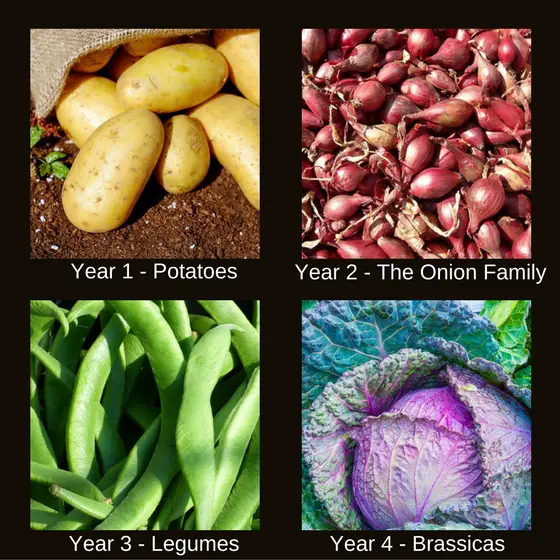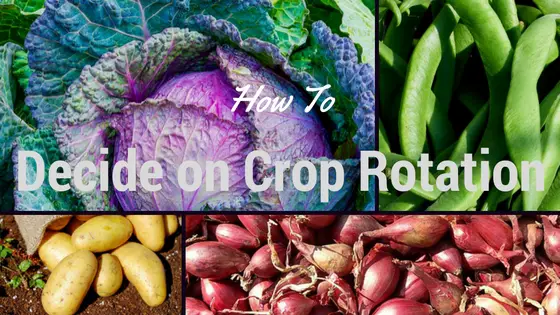A simple vegetable crop rotation can be easy to create. Yet for many beginners, it is confusing as you read several books or ask different people and find they all do it differently.
So just how do we create a simple easy to follow vegetable crop rotation plan that is successful?
The main reasons for rotating your crops is to reduced pests and diseases and allocate areas for your crops which help to improve the soil structure and keep it fertile.
You can choose to rotate your crops in 2,3,4,5 year rotations. With longer rotations being better and 3 years being acceptable and ideally not using the 2 2-year option.
Contents
What is Crop Rotation?
Crop Rotation is a method used by gardeners and allotment owners who grow veg of moving the crops each year so that the same crops are not in the same location. This reduces disease and pests and improves the soil.
Why Rotate Your Crops?
Some crops are prone to pests and diseases. By rotating your crops you help improve your crops chances by either reducing or eliminating these. Not all pests are affected by rotation. The cabbage white butterfly, for instance, will find them where ever they are. By moving your veggies you stop the pests that are there whipping out and devouring the nearby crops. This gives you and your crops more time to grow and establish themselves. And helps to reduce the build-up of the pests in the soil.
Do I have to Rotate My Crops?
No. There are other methods of gardening that do not require you to rotate your crops. These require you to mix your crops and grow many in one area. If you are growing a single type of vegetable in one area, however, (ie all root veg, all legumes (peas, beans, lentils etc) then crop rotation is best.
Why Can It Be Confusing?
When I started, I asked many people and read several books. While everyone agreed that the crops needed to be moved each year no one, not even the books seemed to agree on which goes where and in what order.
The main thing to remember is to rotate them. This in itself helps a great deal. It is years now since I started and still the options and what people actually do vary considerably. I know of people who do not move their runner beans at all when you consider that in their native lands they are annual and not annual this becomes understandable.
Apparently, Monty Don said that it is mainly the potatoes that are the issue and are the most important to move.
How Many Years Do I Rotate?
The minimum amount is for two years. Most people rotate for three years. However, for maximum benefit, four years is the ideal if you can. This gives it time for the diseases to be eradicated.
I rotate as the picture above with four years with root vegetables, onions, beans and peas (although I don’t grow peas as much) and brassicas.
I have also started a winter rotation where I allocate a smaller space t winter crops. although often these end up being used for summer ones instead.
Categories and Order of Planting
It is the categories and planting order that vary depending on where you read or who you ask. If you are rotating you are half way there anyway. There are several guidelines on how best to split them.
For a four-year crop rotation plan:

***
- Root Vegetables – These include things like potatoes and carrots
- Onion Family – Onions, shallots and leeks
- Peas, Beans Legume – Peas, Mangetout, Runner Beans, French Beans etc
- Brassicas – Cabbage, Kale, Cornflour, Broccoli etc
For three years:
- Join the Root Vegetables and the Onion family together
- Peas, Beans and Legume
- Brassicas
The reasoning behind doing it in this order is because the root veg breaks up the ground which makes it easier for the other veg to grow. Onions do not need a rich nitrogen soil. The beans create nitrogen (You need to dig in their roots at the end of their season). The brassicas then follow on as they need the nitrogen. They take out the nitrogen and the cycle starts again.
There are a couple of conflicts with this method is that you are in fact growing the two types of root veg twice in a row.
Also, swedes are root veg and are also prone to club root.
So as you see it is not iron clad.
Video Showing a Simple 4 Year Crop Rotation
This video is interesting as he uses a slightly different crop choice for year 3 and 4.
Using Beds for Easy Crop Rotation
If you grow the traditional way with open soil and decide each time where you want to grow your crops it can quickly become confusing. You will need to keep a note of what went where and when to avoid putting a crop back too early.
If, however, you use beds it is much easier as you simply allocate the beds 1,2,3 and 4 and you just move the crops forward each year. Much like the video.
What Plants Do Not Need To Be Rotated?
There are two types of plants that you do not need to rotate on a yearly basis.
The first is your longer term more permanent crops like apples, asparagus, rhubarb and strawberries (although the later two do need to be moved every few years)
The other is plants that do not suffer from the diseases, like lettuce and other salad leaves which can be planted in with the other slower growing plants if you are short on space. Again it is recommended that you do not plant in the same place all the time.
